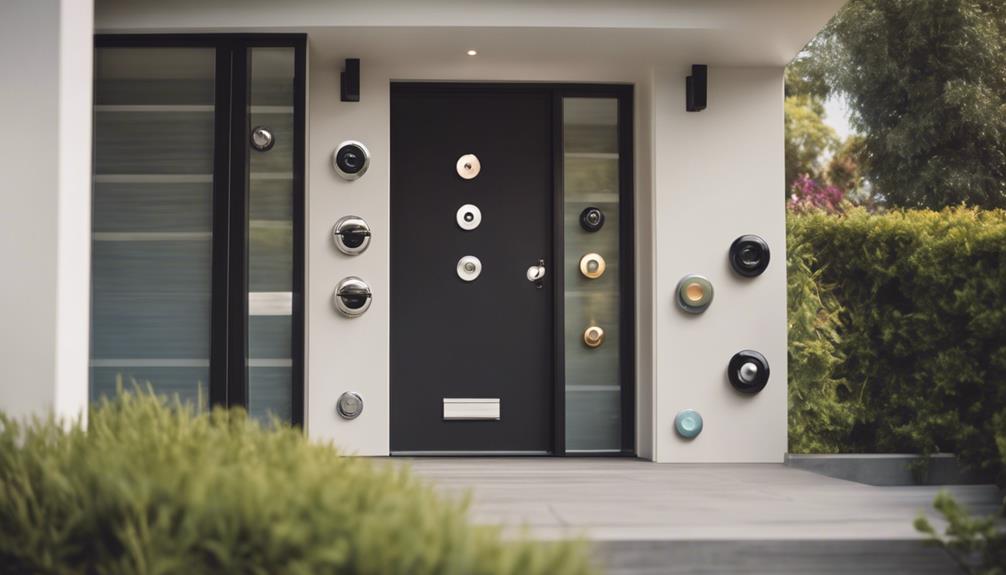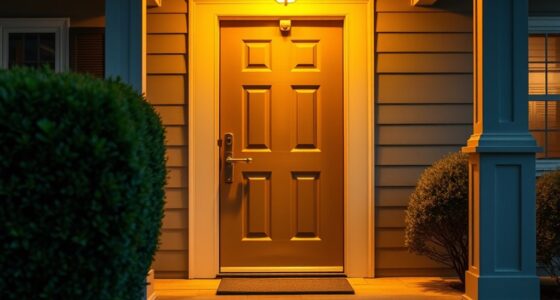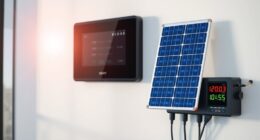Home security systems generally use a minimal amount of electricity. They typically consume between 5 to 30 watts, which is significantly lower compared to many household devices. Basic alarm systems have an average annual consumption of about 35 kWh, while more advanced systems with cameras may use around 200 kWh. Most systems only draw less than 10 watts when on standby. In terms of costs, you can expect to spend around $10 to $30 per year on energy. If you are interested in tips for optimizing energy usage or choosing the right system for your requirements, there is more information available on this topic to explore.
Key Takeaways
- Home security systems typically consume between 5 to 30 watts, making them energy-efficient compared to many household appliances.
- Basic alarm systems average around 35 kWh annually, while complex systems can use up to 200 kWh per year.
- Wired systems generally consume less power than wireless ones, averaging between 5 to 20 watts and relying on a constant power supply.
- Motion sensor alarms save energy by activating only when movement is detected, further minimizing overall electricity usage.
Overview of Power Consumption
When considering a home security system, it's important to understand how much power it actually consumes and how that impacts your electricity bill. Most systems typically consume between 5 to 30 watts, which translates to an annual energy cost ranging from $10 to $30.
If you opt for a basic security alarm, expect it to consume around 35 kWh per year. However, more complex systems—those with multiple cameras and automation features—can escalate power consumption to about 200 kWh annually.
Understanding the energy consumption of appliances like security systems is essential for managing your home expenses and overall efficiency, especially as many devices contribute to energy consumption patterns. Because these systems operate continuously, whether armed or disarmed, they contribute to your overall household energy usage.
Even when on standby, most security systems draw under 10 watts, keeping energy consumption relatively low. This aspect is vital for maintaining manageable electricity costs.
If you're concerned about power consumption, consider investing in energy-efficient alarm models. These can greatly lower your overall power consumption and, consequently, your electricity costs over time.
Types of Security Systems

Home security systems come in various types, each designed to meet different needs and preferences, affecting both their functionality and energy consumption. You can choose from wired, wireless, motion sensor alarms, video surveillance, and Closed Circuit Camera Systems (CCTV). Each of these types has unique power consumption profiles.
When selecting a home security system, consider factors such as reputation and reviews from past clients to guarantee you choose a reliable option.
Basic alarm systems usually consume around 35 kWh per year, making them an energy-efficient choice. However, if you opt for more complex systems with multiple cameras and home automation features, expect power consumption to rise considerably, potentially reaching up to 200 kWh annually.
Motion sensor alarms are another option; they can operate continuously or activate only when detecting movement, which can help you save energy based on your usage patterns. If you're considering security for high-value areas, like museums or casinos, be prepared for added features that increase power consumption compared to standard residential setups.
Lastly, your choice between battery-powered and wired systems impacts not only installation complexity but also ongoing power consumption. Wired systems are generally more tamper-resistant and may provide a more stable energy supply, making them a solid option for long-term security.
Installation and Power Supply

When choosing a home security system, you'll need to contemplate whether to go wired or wireless, as each has its own power requirements.
Wired systems typically require a constant power supply, while wireless ones rely on batteries, which can lead to different energy consumption patterns.
Understanding these needs helps you estimate energy consumption and guarantees your system runs smoothly.
Additionally, exploring backup power solutions can keep your security operational during outages, especially in the event of chronic bronchitis or other health-related emergencies that may require immediate attention.
Wired Vs. Wireless Systems
Deciding between wired and wireless security systems involves understanding their installation requirements and power supply characteristics.
Wired systems typically need modifications to your existing electrical setup, which can be a more extensive process. However, they often provide tamper-resistant features and may include rechargeable backup batteries to maintain functionality during power outages. Their power consumption is generally low, averaging between 5 to 20 watts, with standby power usually under 10 watts. Additionally, using reliable home technology can enhance security measures in your space, such as air purifiers improving indoor air quality.
On the other hand, wireless systems operate on batteries, ensuring they remain functional even during power failures. This aspect makes them easier to install since they don't require extensive wiring. However, you'll need to regularly test and replace the batteries to keep the system running efficiently.
While wireless systems may have slightly higher power usage due to additional components like sensors and communication devices, their overall consumption remains minimal, typically ranging from 5 to 30 watts.
Ultimately, understanding the differences in installation and power supply can help you choose the right system for your needs, balancing energy efficiency with reliability.
Power Requirements Explained
Understanding the power requirements of security systems is essential for guaranteeing reliable operation and effective protection for your home. Most alarm systems operate on low voltage, typically using a 16-volt transformer as their primary power supply. This transformer not only powers the system but also charges a backup battery, which is vital for maintaining functionality during power outages.
Additionally, similar to the importance of choosing the right materials for outdoor ceiling fans, selecting a quality transformer can enhance the efficiency and longevity of your security system.
In general, these backup batteries last about four years, although frequent power outages can shorten their lifespan. If your security system includes wireless sensors, keep in mind that they rely on individual batteries that will need periodic replacement. You'll receive alerts when battery levels are low, helping you stay on top of maintenance.
On the other hand, hardwired sensors connect directly to the backup battery and transformer, allowing them to operate without the need for batteries. This setup can be more reliable, as it minimizes the chances of losing power to individual sensors.
Backup Power Solutions
Backup power solutions are essential for ensuring that your home security system remains operational during outages, providing peace of mind and reliable protection.
Most home security systems operate on low voltage, typically using a transformer that acts as an AC power adapter alongside a backup battery. This setup guarantees that your system stays functional even when the main power goes out. Regular maintenance of your system can enhance its reliability, similar to how heat pump failures can be mitigated through proper care.
The standard transformer is a 16-volt device, about the size of your fist, and it should feel warm when it's working properly. Proper installation is vital; placing the transformer in areas like garages, attics, or closets can help maintain a consistent power supply.
The backup battery in your alarm system usually lasts around four years, but frequent power outages may necessitate an earlier replacement.
If your system has wireless sensors, keep in mind that they rely on individual batteries that need periodic replacement. In contrast, hardwired sensors get their power directly from the backup battery and transformer.
Costs of Running Security Systems

When you install a security system, it's essential to take into account not just the initial investment but also the ongoing costs associated with its operation.
The annual operating costs for running a security alarm system can range from $6.50 to $26, depending on the complexity and energy efficiency of the model.
A typical burglar alarm consumes between 60 to 70 kWh annually, leading to an approximate annual cost of $13 at an average electricity rate of 19.2 cents per kWh in Canada.
To manage expenses effectively, consider implementing a holistic lifestyle approach stress management techniques that can help you save on overall home costs.
If you opt for a more advanced security system with multiple cameras, you could see power consumption rise to about 200 kWh per year, greatly increasing your costs.
Don't forget about maintenance costs, either; regular upkeep of your alarm systems can run you around $80 to $100 every six months.
While these operational expenses can add up, you might find some relief through discounts on your insurance premiums due to your security system's presence.
Balancing these costs will help you make a more informed decision about the long-term investment in your home's safety.
Energy Efficiency Strategies

You can enhance your home security system's efficiency by optimizing its settings and investing in energy-efficient models.
By utilizing smart home integration, you'll not only streamline operations but also reduce energy consumption.
Let's explore how these strategies can help you save on electricity while keeping your home secure.
Optimize System Settings
Optimizing your home security system's settings can lead to significant energy savings while maintaining effective protection. By adjusting your system, you can reduce power consumption and enhance efficiency. Here are some strategies to ponder:
| Strategy | Impact on Energy Use |
|---|---|
| Motion-activated features | Activates only on movement, saving energy |
| Timers/smart plugs | Limits active hours, reducing usage |
| Regular maintenance/testing | Prevents unnecessary energy drain |
Using motion-activated features can drastically cut down on energy usage compared to systems that run continuously. Implementing timers or smart plugs guarantees your system only draws power when necessary, especially for power-hungry components like video surveillance. Plus, regular maintenance of battery-powered sensors helps keep your system running efficiently and alerts you to replace batteries before they drain excessively.
Furthermore, integrating your system with a smart home platform allows real-time adjustments based on usage patterns, maximizing energy efficiency. By taking these steps to optimize system settings, you can enjoy robust security while minimizing your energy footprint.
Invest in Energy-Efficient Models
Investing in energy-efficient home security models can lead to substantial savings on electricity bills while ensuring your safety is never compromised.
These systems are designed to minimize power usage without sacrificing performance. For example, some energy-efficient alarm systems consume as little as 35 kWh per year, compared to more complex systems that can use up to 200 kWh annually.
When choosing a security system, look for options with low standby power—ideally under 10 watts. This helps reduce energy consumption when the system isn't actively monitoring. You can also incorporate timers or smart plugs to optimize power usage, allowing you to control when your system is powered on or off.
If you're considering outdoor security, solar-powered models eliminate electricity costs entirely while providing reliable operation.
Regular maintenance, including battery checks and software updates, can further enhance your security system's efficiency, leading to lower energy consumption over time.
Utilize Smart Home Integration
Smart home integration offers a powerful way to enhance energy efficiency by allowing seamless control and monitoring of security systems from anywhere. With this technology, you can easily manage the operational hours of your security devices. By utilizing timers or smart plugs, you guarantee your systems only run when necessary, greatly cutting down on energy waste.
Moreover, many smart home systems come equipped with automation features that allow security devices to enter low-power modes during inactivity, further reducing electricity usage.
Choosing energy-efficient models of security systems is also vital; these devices minimize standby power consumption, often using less than 10 watts when idle.
Additionally, monitoring energy consumption through smart meters lets you track how much power your security systems are using in real-time. This insight empowers you to make informed decisions about adjustments that can lead to greater energy savings.
Maintenance and Repair Considerations

Regular maintenance and timely repairs are essential for keeping your home security system functioning effectively and efficiently. Neglecting these aspects can lead to costly issues down the line.
To guarantee your alarm system remains in top shape, consider the following:
- Schedule servicing every six months; costs typically range from $80 to $100 per visit.
- Repair costs can vary widely, ranging from $80 to $300 depending on the complexity of your alarm system.
- Make sure to check if your monitored system's monthly fees cover annual servicing costs for added convenience.
- For CCTV systems, maintenance generally averages around $70, while repair costs for cameras can range from $100 to $380.
Long-term Financial Benefits

Installing a home security system not only protects your property but also paves the way for significant long-term financial benefits. By investing in a security system, you can enjoy various savings and potential earnings that make it a smart choice.
| Benefit | Details |
|---|---|
| Insurance Discounts | Many insurance providers offer discounts for homes with security systems. |
| Reduced Theft Losses | Prevents loss from theft, saving you from an average of $2,799 per burglary. |
| Electricity Savings | Expect annual savings of $6.50 to $26 on electricity costs. |
| Increased Property Value | A security system can enhance your home's resale value. |
| Financial Peace of Mind | Less worry about property damage and theft adds to your financial stability. |
These long-term financial benefits make home security systems not just a protective measure, but a wise investment. You'll not only save on potential losses but also enjoy discounts that can offset installation costs, ensuring your investment pays off over time.
Frequently Asked Questions
Does a Security System Use a Lot of Electricity?
You might wonder if a security system uses a lot of electricity. Generally, they consume relatively low power, averaging between 5 to 30 watts, so they won't greatly impact your energy bills.
Do Security Cameras Increase the Electricity Bill?
Yes, security cameras can increase your electricity bill, especially if they're running continuously. However, choosing motion-activated models and energy-efficient options can help reduce their impact on your monthly costs considerably.
Do Security Cameras Use Much Electricity?
You might think security cameras drain a lot of electricity, but they typically use between 2 to 15 watts. Motion-activated models can conserve energy, making them a smart choice for efficient monitoring without hefty bills.
How Much Does It Cost to Run a Security System?
Running a security system typically costs you between $10 to $30 annually. This depends on power consumption and local electricity rates, with average systems using about 50 to 200 kWh per year.
Are Home Security Systems Energy Efficient Despite Emitting Radiation?
Home security systems are designed to emit minimal levels of home security radiation emissions. Therefore, they are generally energy efficient. However, it is important to ensure that the system complies with safety regulations and to minimize exposure to radiation by placing sensors and cameras strategically.
Conclusion
So, you thought home security systems would drain your wallet with high electricity bills?
Ironically, most modern systems are designed to sip power rather than guzzle it.
With energy-efficient options and smart technology, you're not just protecting your home; you're saving money in the long run.
Who knew keeping your home safe could be so easy on the environment and your budget?
Embrace the peace of mind without the shocking energy costs—it's a win-win!









